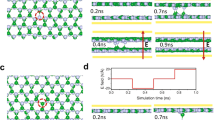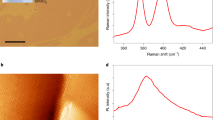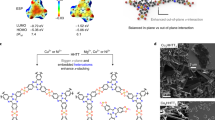Abstract
Two-dimensional (2D) elemental metals, often overlooked owing to their lack of switching or dielectric properties, have the potential to exhibit unique properties unachievable by their bulk counterparts if their microstructure can be controlled. Here we propose an electrodeposition method that utilizes a confined 2D template to prepare elemental metal nanosheets with an aligned grain orientation, resulting in an exceptionally high in-plane electrical anisotropy of >103. Heterogeneous nucleation is initiated and the directed growth of the metal at the cathode is controlled within a channel whose size is smaller than the critical size of the nuclei. This leads to the formation of anisotropic microstructures, and consequently, the nanosheets exhibit anisotropic electrical properties. Unlike conventional field-effect transistors, devices employing a channel with two orthogonally separated conduction paths yield an exceptional on–off switching ratio exceeding 104. Our approach offers a promising route to produce various 2D elemental metals with properties different from those observed in their bulk counterparts and highlights the potential of anisotropic metallic nanosheets as switching elements.

This is a preview of subscription content, access via your institution
Access options
Subscribe to this journal
Receive 12 digital issues and online access to articles
$119.00 per year
only $9.92 per issue
Buy this article
- Purchase on SpringerLink
- Instant access to full article PDF
Prices may be subject to local taxes which are calculated during checkout





Similar content being viewed by others
Data availability
The data supporting the finding of the study are available in the Article and its Supplementary Information. Source data are provided with this paper.
References
Passler, N. C. et al. Hyperbolic shear polaritons in low-symmetry crystals. Nature 602, 595–600 (2022).
Niu, S. et al. Giant optical anisotropy in a quasi-one-dimensional crystal. Nat. Photonics 12, 392–396 (2018).
Simonov, A. & Goodwin, A. L. Designing disorder into crystalline materials. Nat. Rev. Chem. 4, 657–673 (2020).
Paull, O. et al. Anisotropic epitaxial stabilization of a low-symmetry ferroelectric with enhanced electromechanical response. Nat. Mater. 21, 74–80 (2022).
Du, L. et al. Engineering symmetry breaking in 2D layered materials. Nat. Rev. Phys. 3, 193–206 (2021).
Malinowski, P. et al. Suppression of superconductivity by anisotropic strain near a nematic quantum critical point. Nat. Phys. 16, 1189–1193 (2020).
MacNeill, D. et al. Control of spin–orbit torques through crystal symmetry in WTe2/ferromagnet bilayers. Nat. Phys. 13, 300–305 (2017).
Haxhimali, T., Karma, A., Gonzales, F. & Rappaz, M. Orientation selection in dendritic evolution. Nat. Mater. 5, 660–664 (2006).
Chu, J.-H. et al. In-plane resistivity anisotropy in an underdoped iron arsenide superconductor. Science 329, 824–826 (2010).
Sharma, A., Gambino, R. J. & Sampath, S. Anisotropic electrical properties in thermal spray metallic coatings. Acta Mater. 54, 59–65 (2006).
Zheng, P. & Gall, D. The anisotropic size effect of the electrical resistivity of metal thin films: tungsten. J. Appl. Phys. 122, 135301 (2017).
Chargui, A. et al. Anisotropic thermal conductivity of nanocolumnar W thin films. Phys. Lett. A 426, 127878 (2022).
Li, W.-Y., Li, C.-J. & Liao, H. Effect of annealing treatment on the microstructure and properties of cold-sprayed Cu coating. J. Therm. Spray Technol. 15, 206–211 (2006).
Rivnay, J. et al. Large modulation of carrier transport by grain-boundary molecular packing and microstructure in organic thin films. Nat. Mater. 8, 952–958 (2009).
López‐Ríos, T., Briggs, A., Guillet, S., Baro, A. M. & Luna, M. Anisotropic conductivity of silver thin films grown on silicon (100) vicinal surfaces. Appl. Phys. Lett. 66, 529–531 (1995).
Xin, G. et al. Microfluidics-enabled orientation and microstructure control of macroscopic graphene fibres. Nat. Nanotechnol. 14, 168–175 (2019).
Rudan, M., Brunetti, R. & Reggiani, S. Springer Handbook of Semiconductor Devices (Springer, 2022).
Huang, P. Y. et al. Grains and grain boundaries in single-layer graphene atomic patchwork quilts. Nature 469, 389–392 (2011).
Watanabe, T. & Tsurekawa, S. The control of brittleness and development of desirable mechanical properties in polycrystalline systems by grain boundary engineering. Acta Mater. 47, 4171–4185 (1999).
Yazyev, O. V. & Chen, Y. P. Polycrystalline graphene and other two-dimensional materials. Nat. Nanotechnol. 9, 755–767 (2014).
Yu, Q. et al. Control and characterization of individual grains and grain boundaries in graphene grown by chemical vapour deposition. Nat. Mater. 10, 443–449 (2011).
Lin, Y., Pan, J., Zhou, H. F., Gao, H. J. & Li, Y. Mechanical properties and optimal grain size distribution profile of gradient grained nickel. Acta Mater. 153, 279–289 (2018).
Islam, S. M., Hernandez, T. S., McGehee, M. D. & Barile, C. J. Hybrid dynamic windows using reversible metal electrodeposition and ion insertion. Nat. Energy 4, 223–229 (2019).
Menke, E. J., Thompson, M. A., Xiang, C., Yang, L. C. & Penner, R. M. Lithographically patterned nanowire electrodeposition. Nat. Mater. 5, 914–919 (2006).
Gamburg, Y. D. & Zangari, G. Theory and Practice of Metal Electrodeposition (Springer Science & Business Media, 2011).
Kanani, N. Electroplating: Basic Principles, Processes and Practice (Elsevier, 2004).
Martín, H. et al. Growth mode transition involving a potential-dependent isotropic to anisotropic surface atom diffusion change. gold electrodeposition on HOPG followed by STM. Langmuir 13, 100–110 (1997).
Pötzschke, R. T., Gervasi, C. A., Vinzelberg, S., Staikov, G. & Lorenz, W. J. Nanoscale studies of Ag electrodeposition on HOPG (0001). Electrochim. Acta 40, 1469–1474 (1995).
Gimeno, Y., Hernández Creus, A., González, S., Salvarezza, R. C. & Arvia, A. J. Preparation of 100−160-nm-sized branched palladium islands with enhanced electrocatalytic properties on HOPG. Chem. Mater. 13, 1857–1864 (2001).
Vivas, L. G., Escrig, J., Trabada, D. G., Badini-Confalonieri, G. A. & Vázquez, M. Magnetic anisotropy in ordered textured Co nanowires. Appl. Phys. Lett. 100, 252405 (2012).
Vivas, L. G. et al. Magnetic anisotropy in CoNi nanowire arrays: analytical calculations and experiments. Phys. Rev. B 85, 035439 (2012).
Ozel, T., Bourret, G. R. & Mirkin, C. A. Coaxial lithography. Nat. Nanotechnol. 10, 319–324 (2015).
Wen, L., Xu, R., Mi, Y. & Lei, Y. Multiple nanostructures based on anodized aluminium oxide templates. Nat. Nanotechnol. 12, 244–250 (2017).
Ragone, D. V. Thermodynamics of Materials Vol. 2 (Wiley, 1994).
Taberna, P. L., Mitra, S., Poizot, P., Simon, P. & Tarascon, J.-M. High rate capabilities Fe3O4-based Cu nano-architectured electrodes for lithium-ion battery applications. Nat. Mater. 5, 567–573 (2006).
Lee, J., Kim, J. & Hyeon, T. Recent progress in the synthesis of porous carbon materials. Adv. Mater. 18, 2073–2094 (2006).
Zach, M. P., Ng, K. H. & Penner, R. M. Molybdenum nanowires by electrodeposition. Science 290, 2120–2123 (2000).
Braun, P. V. & Wiltzius, P. Electrochemically grown photonic crystals. Nature 402, 603–604 (1999).
Kim, S. et al. Neuromorphic van der Waals crystals for substantial energy generation. Nat. Commun. 12, 47 (2021).
Dennis, J. K. & Such, T. E. Nickel and Chromium Plating (Elsevier, 1993).
Zhou, X. et al. Intrapore energy barriers govern ion transport and selectivity of desalination membranes. Sci. Adv. 6, eabd9045 (2020).
Gilmore, C. Materials Science and Engineering Properties, SI Edition (Cengage Learning, 2014).
Andrews, P. V. Resistivity due to grain boundaries in pure copper. Phys. Lett. 19, 558–560 (1965).
Jokar, E., Iraji zad, A. & Shahrokhian, S. Growth control of cobalt oxide nanoparticles on reduced graphene oxide for enhancement of electrochemical capacitance. Int. J. Hydrog. Energy 39, 21068–21075 (2014).
Yuan, Z. et al. Sandwich-like composites of double-layer Co3O4 and reduced graphene oxide and their sensing properties to volatile organic compounds. J. Alloys Compd. 793, 24–30 (2019).
Nosé, S. A unified formulation of the constant temperature molecular dynamics methods. J. Chem. Phys. 81, 511–519 (1984).
Plimpton, S. Fast parallel algorithms for short-range molecular dynamics. J. Comput. Phys. 117, 1–19 (1995).
Pan, Z., Borovikov, V., Mendelev, M. I. & Sansoz, F. Development of a semi-empirical potential for simulation of Ni solute segregation into grain boundaries in Ag. Model. Simul. Mater. Sci. Eng. 26, 075004 (2018).
Kresse, G. & Furthmüller, J. Efficiency of ab-initio total energy calculations for metals and semiconductors using a plane-wave basis set. Comput. Mater. Sci. 6, 15–50 (1996).
Perdew, J. P., Burke, K. & Ernzerhof, M. Generalized gradient approximation made simple. Phys. Rev. Lett. 77, 3865–3868 (1996).
Momma, K. & Izumi, F. VESTA 3 for three-dimensional visualization of crystal, volumetric and morphology data. J. Appl. Crystallogr. 44, 1272–1276 (2011).
Acknowledgements
This research was supported by the Nano & Material Technology Development Program through the National Research Foundation (NRF) of Korea, funded by the Ministry of Science and ICT (RS-2024-00468995) and the Yonsei University Research Fund (Post Doc. Researcher Supporting Program) in 2022 (project no. 2022-12-0140). This study was supported by a grant from the Institute for Basic Science (IBS-R026-D1).
Author information
Authors and Affiliations
Contributions
Taehoon Kim, D.S., S.K. and W.S. designed the experiments. Taehoon Kim, D.S., S.K., G.W.K., M.L., J.B., H.R., M.K., Taeyoung Kim and J. Choi synthesized the materials. Taehoon.K., D.S., H.C., H.J.L., S.I. and W.S. fabricated the devices and performed the measurements. S.-J.S., S.Y.K., S.L., S.-R.K., J.-W.P., J.S.L. and A.W. performed the simulations. Taehoon Kim, D.S., S.K., G.W.K., J. Choi, J. Cheon and W.S. analysed the characteristics and performed the structural analysis. All authors wrote the manuscript and contributed to the overall scientific interpretation.
Corresponding author
Ethics declarations
Competing interests
The authors declare no competing interests.
Peer review
Peer review information
Nature Synthesis thanks Teng Yang and the other, anonymous, reviewer(s) for their contribution to the peer review of this work. Primary Handling Editor: Alexandra Groves, in collaboration with the Nature Synthesis team.
Additional information
Publisher’s note Springer Nature remains neutral with regard to jurisdictional claims in published maps and institutional affiliations.
Extended data
Extended Data Fig. 1 Electrical anisotropy of existing materials.
The electrical anisotropy of a material is generally determined by its atomic structure. The cubic structure, which is the most isotropic crystal system, is limited to a relatively low electrical anisotropy compared with the high anisotropy of other crystals. The greater the number of elements, the greater the possibility of anisotropy of the atomic structure. Most of the materials with higher electrical anisotropy (for example Bi2Sr2Cu2Ox, MoAlB, V2AlC, and GaTe) among the existing references contain three or more elements (> ternary). Ag, an elemental material with a cubic structure, exhibits high anisotropy (~27) owing to grain elongation, which suggests that microstructural control and grain orientation are related to the anisotropy of the symmetrical structure. The detailed descriptions of each data point are provided in Supplementary Table 1.
Extended Data Fig. 2 Nucleation and growth in 2D template-mediated electrodeposition.
(a) Distribution of electric flux (ΦE) distorted by the template. Through the finite element method simulation results, the electric flux density D (= ΦE /A; ΦE: electric flux, A: area of the surface) is observed to be localized. On a flat cathode surface without a template, electric flux exists in parallel (left). The presence of a template with a lower relative permittivity than that of the surrounding medium distorts the flux at the interface between the two media, regardless of the template shape (templates with cylindrical (1D template, middle) and cuboid-shaped voids (2D template, right)). (b) Grain growth in the 2D template restricts the interlayer space and consequently suppresses the formation of homogeneous nuclei. Within channels with sizes smaller than 2r*, nuclei that surpass the energy barrier for growth cannot be formed. Only heterogeneous nuclei on the cathode surface can attain a radius of curvature greater than r*. (c) Free energy as a function of the radius of homogeneous and heterogeneous nuclei. Points marked on the curves corresponding to states 1 to 3 depicted in (b) for homogeneous nuclei (gray open dots) and heterogeneous nuclei (blue open dots).
Extended Data Fig. 3 Characterization of 2D template-mediated Ni nanosheets with the GO template.
(a) Cross-sectional SEM image of the GO-based template obtained through cross-section polishing (CP) after electrodeposition with Ni, viewed at a tilt angle. The Ni nanosheets are highlighted in blue. (b) XPS spectra of the electrodeposited GO template. Spectra showing peaks corresponding to Ni 2p1/2 and 2p3/2 for the GO-based 2D template before (gray line) and after (blue line) Ni deposition. Two new peaks corresponding to Ni 2p3/2 and 2p1/2 appeared at the binding energies of 852.7 and 869.9 eV, respectively. (c) HAADF STEM images of the GO-based template after Ni electrodeposition.
Extended Data Fig. 4 Device performance of the all-metal three-terminal electrical switch.
(a) Current measured from the source (Is) for the analysis of the gate dependence of the all-metal three-terminal electrical switch using nine combinations of (\({{V}_{d}}^{\perp }\), \({{V}_{d}}^{\,{||}}\)). Fitting is performed using the numerical model (Is = 2\({{V}_{d}}^{\,{||}}\)/Rxx + 2\({{V}_{d}}^{\perp }\)/Ryy). Δ\({{V}_{d}}^{\perp }\)/Δlog(Is) is estimated from the slope between two measurements (between \({{V}_{d}}^{\perp }\) = 0 V and \({{V}_{d}}^{\perp }\) = 10−3 V, inset). (b) Horizontal drain-voltage (\({{V}_{d}}^{\,{||}}\)) dependence of Δ\({{V}_{d}}^{\perp }\)/Δlog(Is) estimated experimentally and calculated using the numerical model. The detailed descriptions of the calculated Δ\({{V}_{d}}^{\perp }\)/Δlog(Is) are provided in Supplementary Note 11. (c) On–off ratio of the all-metal three-terminal electrical switch based on the thickness-dependent electrically anisotropic template-mediated and isotropic sputtered Ni nanosheets. The measured thicknesses of the template-mediated Ni nanosheets prepared using the same method are 24, 45, and 57 nm. A 50-nm-thick isotropic sputtered Ni nanosheet has an on–off ratio of approximately 1.94. In comparison, a template-mediated Ni nanosheet with a thickness of 57 nm exhibits an on–off ratio of approximately 36.54. Reducing the thickness of the template-mediated nanosheet to 45 and 24 nm increases the on–off ratio to 139 and 286, respectively. All the measurements are performed at \({{V}_{d}}^{\perp }\) = \({{V}_{d}}^{\,{||}}\) = 0.01 V, and each measurement is performed for 1800 cycles.
Extended Data Fig. 5 Digital logic gates based on an all-metal three-terminal electrical switch.
(a) Schematic of an anisotropic-metal-based three-terminal device for driving a logic gate. The device has two perpendicular input terminals (IN1(\({{V}_{d}}^{\perp }\)), IN2(\({{V}_{d}}^{\,{||}}\))) and one output terminal (|Is|). (b) |Is|–\({{V}_{d}}^{\,{||}}\) curves for the IN1 = 0 (\({{V}_{d}}^{\perp }\) = 0 mV, gray curve) and IN1 = 1 (\({{V}_{d}}^{\perp }\) = ± 5 mV, blue curves) states. The blue dashed line indicates |Is|th = 4×10−8 A. (c) Numerical prediction of |Is|–\({{V}_{d}}^{\,{||}}\) curves with (\({{V}_{d}}^{\perp }\) = 5 mV) and without (\({{V}_{d}}^{\perp }\) = 0 V) \({{V}_{d}}^{\perp }\) depending on the electrical anisotropy (Rxx/Ryy). As the electrical anisotropy increases, the magnitude of the curve shift (Vshift) increases. The numerical approach involving variations in electrical anisotropy (Rxx/Ryy) is conducted while maintaining a constant Ryy = 1.89 × 105 Ω. (d-h) Truth tables (upper table) and schematics of output current levels (|Is|) for the four input states ((IN1, IN2) = (0,0), (0,1), (1,0), and (1,1)) on the |Is|–\({{V}_{d}}^{{||}}\) curves (bottom graph) of (d) OR, (e) NAND, (f) NOR, (g) XNOR, and (h) XOR gates. (i-m) Logic input (IN1, IN2) (two upper graphs) and measured output current levels (|Is|) (bottom graph) for the logic behaviors of the (i) OR, (j) NAND, (k) NOR, (l) XNOR, and (m) XOR gates. The four continuously changing (IN1, IN2) states ((0,0), (0,1), (1,0), and (1,1)) have 20 measurements each with intervals of 60 ms, for a total of 4800 ms. The blue dashed line indicates |Is|th = 4×10−8 A.
Supplementary information
Supplementary Information
Supplementary Figs. 1–43, Tables 1–12 and Notes 1–13, captions of Supplementary Videos 1 and 2, and Supplementary References.
Supplementary Video 1
Molecular dynamics simulation demonstrating ion entrance into the GO channel.
Supplementary Video 2
Molecular dynamics simulation of Ni growth in a GO template with a 5 Å interlayer gap, predicting Ni nuclei growing from the cathode surface.
Source data
Source Data Fig. 1
Source data for Fig. 1.
Source Data Fig. 2
Source data for Fig. 2.
Source Data Fig. 3
Source data for Fig. 3.
Source Data Fig. 4
Source data for Fig. 4.
Source Data Fig. 5
Source data for Fig. 5.
Source Data Extended Data Fig. 3
Source data for Extended Data Fig. 3.
Source Data Extended Data Fig. 4
Source data for Extended Data Fig. 4.
Source Data Extended Data Fig. 5
Source data for Extended Data Fig. 5.
Rights and permissions
Springer Nature or its licensor (e.g. a society or other partner) holds exclusive rights to this article under a publishing agreement with the author(s) or other rightsholder(s); author self-archiving of the accepted manuscript version of this article is solely governed by the terms of such publishing agreement and applicable law.
About this article
Cite this article
Kim, T., Seo, D., Kim, S. et al. Anomalous in-plane electrical anisotropy in elemental metal nanosheets. Nat. Synth 4, 31–42 (2025). https://doi.org/10.1038/s44160-024-00669-4
Received:
Accepted:
Published:
Issue date:
DOI: https://doi.org/10.1038/s44160-024-00669-4
This article is cited by
-
Metallic nanosheets fill the gap
Nature Synthesis (2024)



